During the rise of the COVID-19 pandemic, the event industry quickly adopted virtual engagement to continue its day-to-day business. However, the post-pandemic world set a new trend of hybrid events, blending the best of virtual and in-person interactions. This format not only enhances accessibility but also flexibility and participant engagement with the content. In this guide, you will learn what is a hybrid event so you can plan and execute an event successfully.
What are Hybrid Events?
When seminars, career fairs, conferences, trade shows, and other events are held live online and in-person simultaneously, they are called hybrid events. They are pre-arranged events that provide a similar experience to remote and on-site attendees with the use of the right technology. Primarily, hybrid events gained popularity during the COVID-19 pandemic, allowing businesses and the education sector to continue their meetings.
At such events, attendees can interact with speakers and other in-person attendees through the engagement features. Depending on the setup and technologies involved, virtual attendees can hear and view the presentation slides during the live stream. Through virtual components in events, people across the globe can join exhibitions, book signing events, music concerts, etc.
Pros and Cons of Hybrid Events
If you are scheduling a hybrid event, you must consider every aspect before jumping into it. For your help, this section collects and presents some advantages and drawbacks of hybrid events. Without further delay, you can review them and see if hybrid event solutions offer a great deal.
Pros
- Largest Reach: The most obvious pro of hybrid events is increased attendance when your event is accessible to everyone around the globe. According to statistics, 50% of virtual attendees have never joined an on-site version of a meeting or conference.
- More Marketing Data: Hybrid events refer to online participants’ behaviors that help researchers collect valuable data for analysis. This allows them to identify trends, devise marketing campaigns, and attract corporate sponsors.
- Lower Cost: A larger face-to-face event is associated with higher costs that can be saved through hybrid events. It minimizes travel, rental areas, and food expenses while reducing the environmental impacts a physical event can cause.
- Greater Diversity: You can include international speakers in hybrid events, which isn’t sometimes possible with conventional methods. Additionally, they support higher audience engagements through Q&A sessions with the virtual audience.
Cons
- Connectivity Issues: When conducting or joining a hybrid meeting, you must be aware of unexpected connectivity issues. According to 67% of event organizers, hybrid events will only succeed if you use advanced technology and a reliable network.
- More Planning Efforts: Hybrid events are like two events simultaneously, demanding double the planning effort. You have to ensure the interaction of on-site participants, virtual attendees, and everyone present at the event with the speaker.
- Technological Investments: Event organizers must make an initial investment in technology to guarantee smooth online streaming. Apart from buying reliable technologies, you need to train the employees accordingly to handle the live stream afterward.
- Networking Issues: Choosing the right location for the setup is also a headache, as you must consider sitting arrangements and a Wi-Fi connection. Keeping the audience engaged sometimes becomes difficult because the current generation has attention deficiencies.
Types of Hybrid Events
Aside from its drawbacks, a hybrid event platform has undeniable benefits that cannot be overlooked. Hence, you should familiarize yourself with the types of such events to analyze and maximize their potential.
1. Live-Studio Audience Events
In such an event, a panel of speakers and presenters discusses a topic in the same physical venue while live-streaming it to the audience virtually. It is simpler to organize because the audience doesn’t have to interact with hosts directly, but a full production setup is still required. For instance, there are Apple events and award shows where the virtual audience can hear the host and on-site audience’s excitement.
2. Hub and Spoke Events
This event type focuses on live streaming a session from a main location to an audience across other smaller locations. It suits people with audiences scattered across different locations, but the attendees can engage in smaller groups. For example, company board members can hold hybrid conferences with branches in different countries.
3. Simultaneous Events
It’s the most obvious and common type of hybrid event, and you can host a virtual and an on-site event simultaneously. An advantage of such kind of events is that everyone can access the same information and interact with others at any location. Moreover, the virtual attendees get an equal chance to participate as the physical event attendees.
4. On-Demand Events
On-demand events are captured with the intent of wider distribution and are well-suited for educational lectures and demonstrating expertise. If you are having an event stacked with high-profile speakers and hot industry topics, this format would be successful. It is because they can share such valuable information with others across the globe immediately or over time.
Why Live Stream Your Hybrid Events?
Live streaming events and turning them into hybrid ones can help you take advantage of in-person and virtual aspects. If you are a newly landed marketer and want to clarify why brands prefer hybrid events, read this section.
- KPIs Tracking: Tracking the number of attendees at on-site events seems overwhelming. Therefore, brands hold hybrid events to obtain event KPIs for future event planning. Such metrics may help hosts improve speaker lineups and upcoming marketing strategies.
- Enhanced Turnover: Content creators have significantly witnessed an engaging audience in the hybrid events. They claim such events reduce financial burdens on hosts and participants while attracting secondary and territory audiences.
- More Scalability & Flexibility: Choosing a hybrid approach offers greater flexibility and minimizes the external factors that can hinder an on-site event. You should livestream a hybrid event to expand your content reach within flexible circumstances.
- Impactful Events: If you are organizing an impactful event that everyone is eager to join, you must keep it live stream. Doing that will facilitate people who wish to join but are unable to because of some urgent errands. Live streaming events will help them attend while commuting or elsewhere on their phone.
What Do Hybrid Events Look Like?
Upon knowing the hybrid meeting’s meaning and types, if you are unclear about what it would look like, you must delve into this section. Here, you will find several forms of hybrid events that can fulfill different organizational goals and gain popularity.
- Hybrid Presentations: If an attendee cannot travel for some reason, a hybrid event will greatly relieve them. In such events, speakers and hosts simultaneously present valuable information to in-person and virtual participants while engaging with them through polls and Q&A.
- Conferences: Moreover, a conference is similar to a hybrid presentation, but a larger audience attends the session through live streaming. Online attendees can access live speakers’ sessions and panel discussions through breakout rooms as well, depending on the software.
- Trade Shows: Moving forward, another example of hybrid events is a trade show where retailers showcase their products to virtual and in-person buyers. It involves product demonstrations, order sheets, and live chats where customers ask questions about the products, a new way to generate business.
- Exhibitions: Hybrid exhibitions provide a great opportunity for organizations like art galleries to educate people worldwide. Through them, nonprofit organizations and schools showcase their work, celebratory events, fashion theses, and research virtually with other interested people.
- Career Fairs: Recruiters and local job seekers busy in their daily routines find the hybrid mode of career fairs extremely fruitful. In this way, companies offer remote job positions and hire candidates from educational institutions with satisfaction.
5 Best Hybrid Event Platforms in 2026
Whether it’s a trade show, corporate conference, or social gathering, hybrid meetings are a great solution to many problems. However, event organizers need reliable hybrid meeting technology to make them successful and immersive. To expand your knowledge related to available technologies, this section has enlisted 5 leading hybrid event platforms that you can review.
1. vFairs
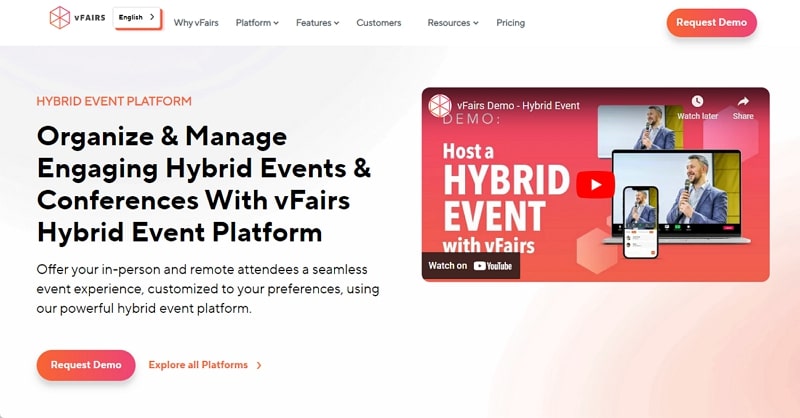
The first reliable hybrid platform is vFairs, an all-in-one event management platform for running hybrid conferences, summits, open days, and more. This feature-rich and user-friendly platform extends its services to mobile applications and delivers cutting-edge 3D graphics of physical venues. Moreover, it offers live streaming, breakout rooms, live chat, a virtual photo booth, and cross-channel networking for virtual attendees.
2. Bizzabo
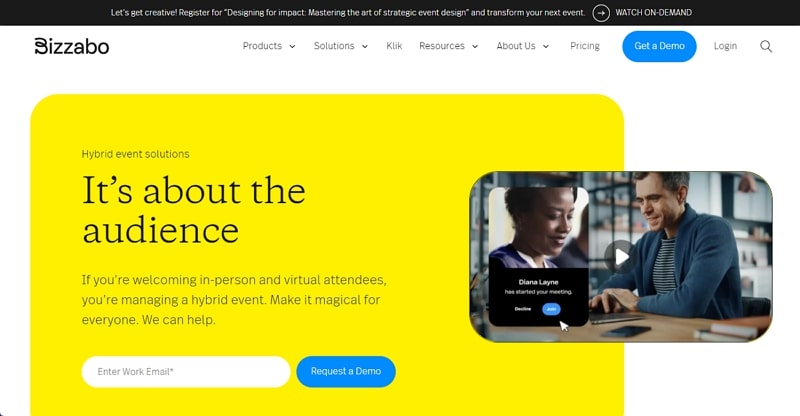
Bizzabo will be a helpful platform for extending your brand reach as it helps sponsors engage more attendees through its features. They can open a pre-session lounge, hold Q&A sessions, and start specialized chat channels to let the conversation flow. Besides, this hybrid event solution integrates your existing tech stack to leverage your customizable, reliable, and scalable experience.
3. BigMaker
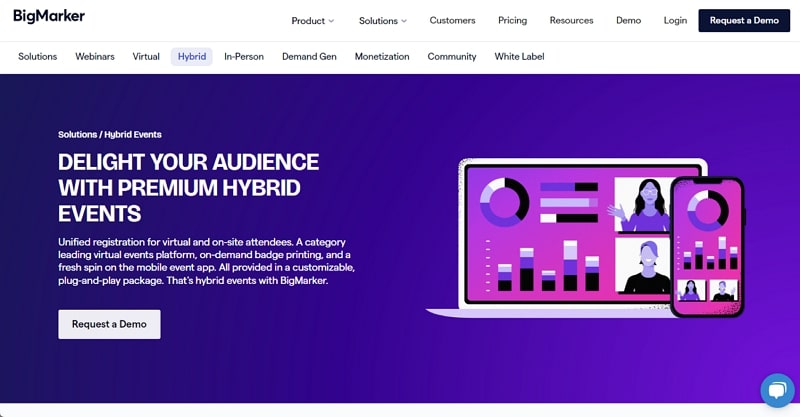
It’s a complete suite of communication that facilitates hybrid meetings, virtual events, in-person meetings, and webinars. For hybrid events, it provides customizable plugins for live-streaming and interactive Q&A sessions. Furthermore, it supports secure payments and registrations to prevent unauthorized access that can disrupt the session.
4. Swapcard
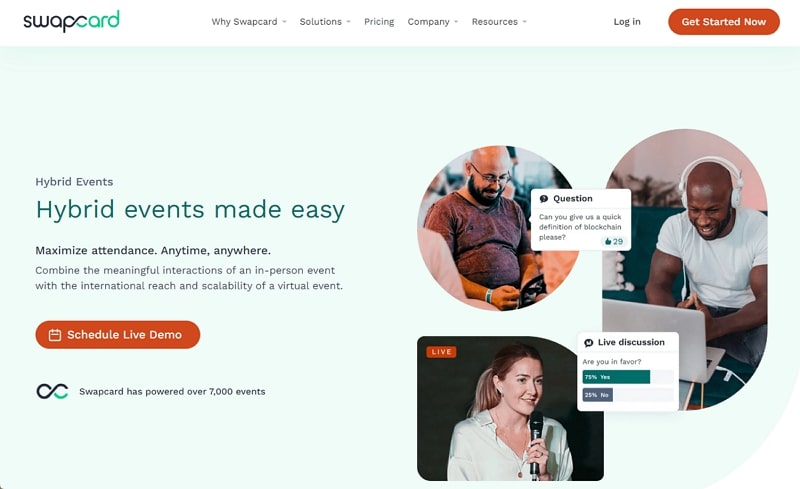
This hybrid event platform is designed to combine in-person event interactions with the international reach of a virtual event. Therefore, it provides event registration over an app to ensure on-site and virtual attendance. Additionally, it has on-site servers, lead capture, help-desk staffing, and technical services for event organizers to plan everything strategically.
5. InEvent
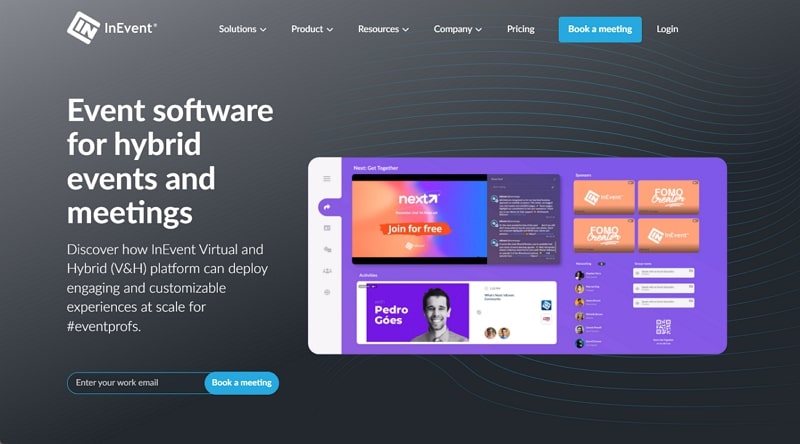
Another good hybrid meeting technology is InEvent, which provides tailored solutions for event planners. Such solutions involve registrations, emails, data management, check-ins, live studio, and mobile apps. Therefore, it will keep in-person and virtual attendees engaged through surveys, Q&A, polls, and gamification. To hosts, it can even provide attendee feedback, engagement scoring, web analytics, and customizable web links.
How to Create a Successful Hybrid Event
After gathering all information related to hybrid event platforms, it’s time to head towards planning a real-time event. To make it successful, you are suggested to read the following step-by-step guide demonstrating effective hybrid event management strategies.
Step 1: Define Strategy and Plan Content
Before diving into the content, define your event strategy and identify the reasons for holding a hybrid event. You should be clear about your goals and key performance indicators (KPIs). Later, determine the type of content that will fascinate and engage the targeted audience. Afterward, adopt different content delivery formats such as demos, workshops, expert interviews, and panel discussions.
Step 2: Choose the Right Technology
Selecting the appropriate technology is crucial for a hybrid event. You’ll need a reliable platform that supports live streaming, virtual interactions, and possibly virtual reality components. For live streaming capabilities, integrating a robust live streaming SDK like ZEGOCLOUD can enhance the quality and reliability of your event broadcasts. Ensure the technology is user-friendly and provides robust support for both attendees and presenters. Consider tools for interactive sessions like Q&A, polls, and chat features to engage online attendees.

Step 3. Plan Content for Both Audiences
Develop content that is accessible and engaging for both live and virtual attendees. This might include live presentations that are streamed online, interactive sessions where remote participants can participate in real-time, and on-demand content that can be accessed at any time. Ensure that all presentations are optimized for both viewing formats.
Step 4. Conduct Technical Rehearsals
Before the event, conduct several technical rehearsals to troubleshoot potential issues and ensure all technology works seamlessly. Test audio and video quality, transition times between live and virtual segments, and the user experience on the event platform from various devices.
Step 5. Engage and Follow Up
Engagement doesn’t end when the event does. Plan for post-event engagement strategies such as follow-up emails, surveys, and access to recorded sessions. This not only extends the life of your event content but also helps maintain the connection with your audience, gathering valuable feedback for future events.
Conclusion
To wrap up, hybrid events are a new and trending mode of communication, proving ease to worldwide attendees. This article explored the in-depth related to this concept, explaining its types, benefits, drawbacks, and examples. Now, if you wish for a successful hybrid event, you should incorporate ZEGOCLOUD APIs and SDKs in your technology to elevate communication in sessions.
Read more:
Hybrid Events FAQ
Q1: What is the difference between virtual and hybrid events?
A virtual event takes place entirely online, with participants joining through digital platforms.
A hybrid event combines both online and in-person elements, allowing attendees to join either physically or virtually.
Q2: What are the five types of events?
The five common types of events are corporate events, social events, educational events, entertainment events, and fundraising events.
Q3: What is an example of a hybrid meeting?
A hybrid meeting could be a company conference where some team members gather in person at the office while others join remotely through a video conferencing platform.
Q4: What is the trend in hybrid events?
Hybrid events are becoming more interactive and tech-driven, using real-time streaming, virtual networking, and audience engagement tools to create a seamless experience for both online and in-person participants.
Let’s Build APP Together
Start building with real-time video, voice & chat SDK for apps today!










